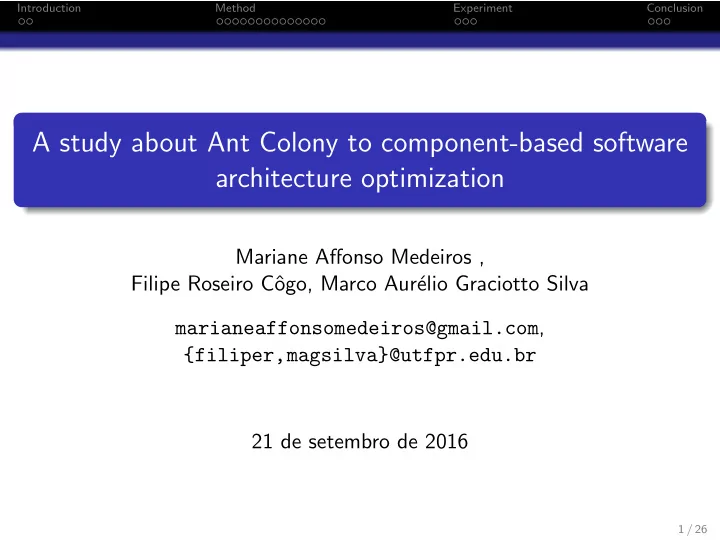

Introduction Method Experiment Conclusion A study about Ant Colony to component-based software architecture optimization Mariane Affonso Medeiros , Filipe Roseiro Cˆ ogo, Marco Aur´ elio Graciotto Silva marianeaffonsomedeiros@gmail.com , {filiper,magsilva}@utfpr.edu.br 21 de setembro de 2016 1 / 26
Introduction Method Experiment Conclusion Introduction Some works that propose optimization of component-based software architecture. [ Hussain-etal:2015 ] Particle Swarm Optimization - PSO; [ Ramirez-etal:2015 ] Genetic Algorithm; [ Mueller:2014 ] Ant Colony Optimization (ACO); 2 / 26
Introduction Method Experiment Conclusion Introduction Some works that propose optimization of component-based software architecture. [ Hussain-etal:2015 ] Particle Swarm Optimization - PSO; [ Ramirez-etal:2015 ] Genetic Algorithm; [ Mueller:2014 ] Ant Colony Optimization (ACO); Lack of approaches that consider architectural style during the optimization. 2 / 26
Introduction Method Experiment Conclusion Objective Objective The aim of this study is to observe the behavior of Ant Colony to optimization of component-based software architecture, considering coesion, coupling and preservation of the architectural style. Comparison of proposed solutions by algorithm with the original architecture; Observe how is the evolution of metric value in relation to values assigned to the parameters of metaheuristic. 3 / 26
Introduction Method Experiment Conclusion Method 4 / 26
Introduction Method Experiment Conclusion Method 5 / 26
Introduction Method Experiment Conclusion Representation of Architecture Model UML Model; API UML2 to process the UML model; From UML model we extract the informations: Number of classes; Number of packages Relationships between classes and packages; Relationships between classes of the architecture. Recovery UML Model; plugin Eclipse Modisco; 6 / 26
Introduction Method Experiment Conclusion Method 7 / 26
Introduction Method Experiment Conclusion Style Representation Architecture style considered: Layered Architecture; Profiles and Stereotypes UML. Profile defined: ArchitectureStyle ; Stereotype defined to layered architecture: Layered 8 / 26
Introduction Method Experiment Conclusion Method 9 / 26
Introduction Method Experiment Conclusion Problem Representation Matrix that represents relationships between classes and components; Comp1 Comp2 Comp3 N C1 0.5 0.5 0.7 0.5 C2 0.5 0.7 0.5 0.5 C3 0.5 0.5 0.5 0.5 C4 0.5 0.8 0.7 0.5 Matrix that represents relationships between classes; C1 C2 C3 C4 N C1 0.5 0.6 0.5 0.5 0.5 C2 0.5 0.5 0.5 0.5 0.5 C3 0.5 0.5 0.5 0.5 0.5 C4 0.5 0.5 0.5 0.5 0.5 10 / 26
Introduction Method Experiment Conclusion Method 11 / 26
Introduction Method Experiment Conclusion Metric and Objective Function Metrics to evaluate architecture quality: Coesion; Coupling. This two metrics are encapsulated in a objective function called: Modularization Quality (MQ) � k � k i , j =1 E i , j i =1 A i se k > 1 − k k · ( k − 1) MQ = (1) 2 se k = 1 A 1 12 / 26
Introduction Method Experiment Conclusion Architecture Style To check if architecture style is violated we use penalizations; We apply penalizations to the relationships that break the rules of architecture style; � total i + total j 1 − if there is style totalGeralDeQuebrasDaRegra penalidade i , j = (2) 1 if there is no style 13 / 26
Introduction Method Experiment Conclusion Method 14 / 26
Introduction Method Experiment Conclusion ACO to Architecture Optimization 15 / 26
Introduction Method Experiment Conclusion ACO to Architecture Optimization 16 / 26
Introduction Method Experiment Conclusion Method 17 / 26
Introduction Method Experiment Conclusion Experiment Version 1.1.0 of software Apache Ant; Realized 1 experiment; To each test done, we apply many combinations of the parameters configuration ( ρ , α , β , number of ant and iterations); Each configuration was performed 10 times; Project Classes Components Layers MQ Apache Ant 1.1.0 97 7 6 0.55534 18 / 26
Introduction Method Experiment Conclusion Distribution of classes in components 19 / 26
Introduction Method Experiment Conclusion Evolution of MQ and Penalties 20 / 26
Introduction Method Experiment Conclusion Conclusion ACO has achieved value of MQ 11% higher than original architecture; The MQ metric tends bring to zero the number of external relationships, causing that the layered architecture style do not be contravened; However, if consider fewer iterations we observed that the number of penalties, to solutions that have values attributed to beta, is smaller than the solutions that were not attributed beta values. 21 / 26
Introduction Method Experiment Conclusion Future Works Apply more experiments, with other projects; Evaluate others architecture styles; Do the multi-objective metaheuristic; 22 / 26
Introduction Method Experiment Conclusion A study about Ant Colony to component-based software architecture optimization Mariane Affonso Medeiros , Filipe Roseiro Cˆ ogo, Marco Aur´ elio Graciotto Silva marianeaffonsomedeiros@gmail.com , {filiper,magsilva}@utfpr.edu.br 21 de setembro de 2016 23 / 26
Number of classes and internal and external relationships of Apache Ant 1.1.0 with architectural style 24 / 26
Results obtained by ACO to version 1.1.0 without architectural style Id Iterations Ants ρ α β MQ 1 100 15 0.2 0.4 0.2 0.61802 2 100 5 0.4 0.2 0.2 0.61765 3 100 15 0.4 0.2 0.4 0.61033 4 100 5 0.1 0.9 0.8 0.59660 5 50 20 0.7 0.4 0.9 0.59499 6 30 20 0.4 0.6 0.9 0.59274 7 20 20 0.6 0.4 0.1 0.59023 25 / 26
Results obtained by the ACO to version 1.1.0 with architectural style Rel. Id Iterations Ants ρ α β MQ Penalizados 1 50 20 0.7 0.4 0.0 0.60244 0 2 100 15 0.8 0.2 0.4 0.60019 0 3 30 20 0.7 0.4 0.3 0.59660 3 4 30 20 0.7 0.4 0.7 0.59563 0 5 20 20 0.5 0.4 0.1 0.58182 8 6 20 20 0.2 0.4 0.1 0.56292 16 26 / 26
Recommend
More recommend